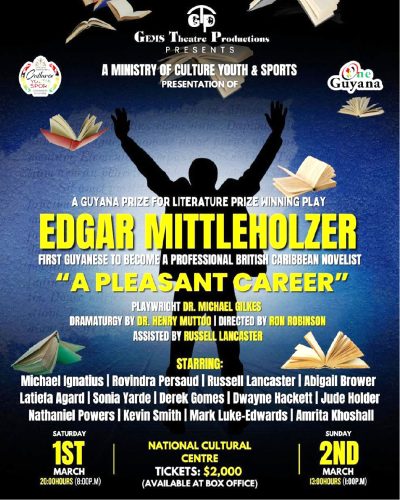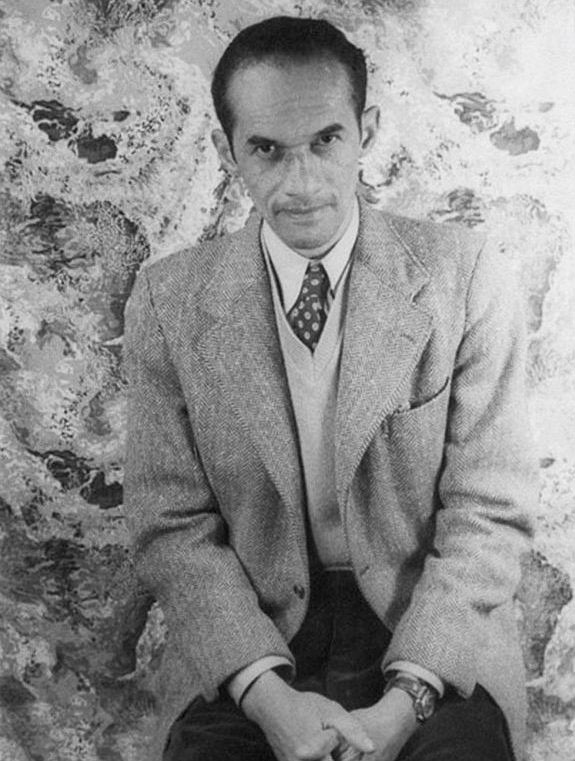 Edgar Austin Mittelholzer (1909 – 1965) holds a very special place in Guyanese and West Indian literature – renowned as one of the nation’s most important novelists. He was the founder of social realism in Guyanese fiction and was the first West Indian writer to gain the distinction of making “a pioneering and professional career out of writing novels. . . . The measure of his literary success can be deduced by the translation of several of his 22 novels into at least six European languages” (Juanita Cox).
Edgar Austin Mittelholzer (1909 – 1965) holds a very special place in Guyanese and West Indian literature – renowned as one of the nation’s most important novelists. He was the founder of social realism in Guyanese fiction and was the first West Indian writer to gain the distinction of making “a pioneering and professional career out of writing novels. . . . The measure of his literary success can be deduced by the translation of several of his 22 novels into at least six European languages” (Juanita Cox).
Mittelholzer was born in New Amsterdam, British Guiana, to a middle class family of mixed ancestry and grew up there where he persevered in writing till the first acceptance of his novel Corentyne Thunder by an English publisher in 1941. He left Guyana to live in different countries, but mostly in Great Britain, followed by Trinidad. He experienced numerous obstacles, first at home in a colonial society vividly painted in such other novels as Sylvia (1953), My Bones and My Flute (1955) and the self published collection Creole Chips (1937), and in the UK where he eventually settled.
This life of Mittelholzer was documented and dramatised in a play, A Pleasant Career (1992) by Michael Gilkes, leading Guyanese playwright, director, poet, film maker, academic and critic. It was the first winner of the Guyana Prize for Drama in 1992 but was never publicly performed until 2025. This stage version.was dramaturged by director and designer Henry Muttoo.  A Pleasant Career was the seventh Guyana Prize Winning play to be produced under the Minister of Culture’s initiative, started in 2023, to sponsor plays which have won awards in the Guyana Prize. In this scheme the Department of Culture provides all the funds for private producers to stage these plays and earn income from the performances.
A Pleasant Career was the seventh Guyana Prize Winning play to be produced under the Minister of Culture’s initiative, started in 2023, to sponsor plays which have won awards in the Guyana Prize. In this scheme the Department of Culture provides all the funds for private producers to stage these plays and earn income from the performances.
This drama was produced by GEMS Theatre Productions, managed by Gem Madhoo-Nascimento and directed by Ron Robinson, assisted by Russel Lancaster on March 1 and 2, 2025 at the cultural centre. It was performed on a set designed by Muttoo and Lancaster, stage managed by Sonia Yarde with make-up by Kim Fernandes and costuming by Rhonda Adams and Omodella Morriah.
It is a period play and very much documentary. It seeks to take us over Mittelholzer’s youth in the 1930s through his later life and career up to the early 1960s. Director Robinson was at pains to capture the periods with various techniques and to overcome the heavily documentary characteristics, and these attempts accounted for the way the play unfolded.
This docu-drama was structured around a narrator describing characters, incidents, place, with each sequence of narrative followed by scenes from the past – Mittelholzer’s life, various experiences and scenes from his works. This made it quite wordy with little bursts of drama but not necessarily very interesting. As a strategy to correct this, the narrator was one of the characters – Jules Pereira (Rovindra Persaud), a Portuguese friend of the young Mittelholzer. Pereira carried this very well and was a fairly striking character with a personality, making the story easier to follow. As an actor, he achieved what was required of him.
But in spite of his very good performance, in most cases the sequence of narratives and flashbacks did not flow seamlessly. There was need for more to be done to effect interesting dramatisation and at times the audience was not able to follow. Despite some commendable attempts, story and character did not command audience attention. The enigmatic character of “Barno” (Michael Ignatius), as Mittelholzer was called by his friends and acquaintances, was more described than played. Ignatius did not quite manage to give us that personality.
There were several of those flashback scenes with a multiplicity of characters in which the performers did not always get the chance to build and sustain a character. A few of them did stand out, such as Latiefa Agard as Rosamund, Nathaniel Powers as Jeremy, Derek Gomes in multiple roles, including Edgar’s father and the judge, as well as Amrita Khoshall as the Interviewer and Mark Luke-Edwards as the reader and George Lamming. Most performers were called upon to play multiple small roles.
In telling these stories about the determined and ever ambitious novelist, the play took great pains to recreate the atmosphere and a sense of place in the periods of the past. Among the techniques was the employment of photographs of buildings and other images projected on the cyclorama. These might have had some scenic effects but were of little dramatic value and did not help to make the action more interesting. Other attempts worked better as theatre, such as the ever present background of the Second World War (1939 – 1945) and the sound of some old calypsos with their historical content/lyrics and old gramophone flavour.
A great deal of work seems to have gone into make-up, hair and costuming in order to capture the past age. These were inconsistent and not uniformly successful, being often more distracting than convincing, but generally calling attention to themselves and being conspicuous for the wrong reasons.
The lighting, too, worked to capture some of the scenes, but failed in so many others. There was a bit too much darkness in some places and for long periods the actors’ faces were not lit. the cultural centre is notorious for non-functioning technical equipment and the malfunction in sound was in evidence. Around the stage, sound quality was quite uneven.
The Programme Notes highlighted the use of set, which was claimed to be “minimalist”. Technically, it was not, as there was an uncomfortable mix of Naturalistic and Modernist set. The play covers many scenes set in many different places and locations, which would be a challenge to any production. Modern minimalist usage would be the best option. But this was only half used. Some scenes were realistically constructed and these worked effectively.
In contrast to those was the attempt to use boxes to accommodate the many differences and minimise cumbersome scene changes. At first there was an impressive use of unspecified, unidentified characters uniformly dressed in gowns, who stepped forward and unrobed themselves to become characters, and play roles as became necessary. That was good for a while, but did not last, as it was thereafter quite inconsistent and practically abandoned as a theatre technique. This left grey, robed figures simply sitting on boxes, unused and sometimes getting in the way.
The use of the boxes, quite promising as minimalist theatre, soon fell away as well, leaving the objects simply abandoned there on the stage, unused. It proved an uncomfortable stage experiment, since the production remained predominantly realistic in design and execution.
Gilkes’ “A Pleasant Career” took on the very demanding task of trying to dramatise the life and work of this famous and complex novelist who moved from country to country including British Guiana, Trinidad, Barbados, Canada and England in his quest for satisfaction as a professional writer. The play delved into the use of scenes from the novels, bringing to life characters created by Mittelholzer and having the novelist possessed by and playing his own characters.
This was an attempt to understand the enigmatic character that his friends knew familiarly as “Barno”, but who remained a bit perplexing and strange to them. This drama strove to get the contemporary audience to understand him better. It was an even greater task to get the modern Guyanese audience, many of whom know very little about him, to appreciate the moody, talented, persevering and determined artist who was honoured in the West Indies, recognised in the UK, and who was among Guyana’s greatest fiction writers. The attempt also brought to a live audience yet another play that won the Guyana Prize for Drama.










